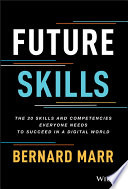

In a rapidly changing world, the concept of lifelong learning has become paramount. The book emphasizes that skills become obsolete quickly, especially in technology-driven sectors. To remain relevant, individuals must cultivate a mindset that values continuous education and adaptability. This involves not only formal education but also self-directed learning, online courses, workshops, and real-world experiences. Lifelong learning equips people with the tools to navigate the complexities of modern work environments and fosters resilience against job displacement due to automation.
Continue readingAs technology permeates every aspect of life, digital literacy is no longer optional; it's essential. The book discusses the importance of understanding digital tools, data analytics, and emerging technologies such as AI and blockchain. It argues that individuals must not only be consumers of technology but also creators and innovators. This proficiency allows for better decision-making, enhances productivity, and opens up new career opportunities. The text provides practical strategies for enhancing digital skills, including engaging with tech communities and leveraging online resources.
Continue readingWhile technical skills are important, the book highlights that soft skills, particularly emotional intelligence, are equally vital in the workplace. Skills such as communication, empathy, collaboration, and conflict resolution are crucial for effective teamwork and leadership. The text explains how emotional intelligence allows individuals to navigate interpersonal relationships more effectively, fostering a positive work environment. It encourages readers to develop these skills through practice and self-reflection, emphasizing that they are often the differentiators in career advancement.
Continue readingCreativity is positioned as a critical skill for the future workforce. The book argues that in a landscape dominated by automation and AI, human creativity remains irreplaceable. It encourages individuals to cultivate their creative abilities by engaging in diverse experiences, brainstorming sessions, and collaborative projects. The text also discusses how organizations can foster a culture of innovation, which not only enhances employee satisfaction but also drives business success. Readers are urged to embrace failure as a learning opportunity and to think outside the box.
Continue readingThe ability to adapt to change is a recurring theme in 'Future Skills.' The book outlines how the pace of change in technology and society requires individuals to be flexible and resilient. Adaptability involves being open to new ideas, willing to change one's approach, and learning from setbacks. Resilience, on the other hand, is about maintaining a positive attitude and recovering from difficulties. The text provides strategies for building these traits, such as mindfulness practices, setting realistic goals, and developing a supportive network.
Continue readingThe importance of networking is underscored throughout the book. Building a strong professional network can provide access to opportunities, insights, and resources that are essential for career growth. The text advises readers on effective networking strategies, such as engaging in industry events, leveraging social media platforms, and nurturing relationships through genuine interactions. It emphasizes that networking is not just about self-promotion but about creating mutually beneficial relationships that can lead to collaborative opportunities.
Continue readingIn an increasingly interconnected world, having a global perspective is vital. The book discusses the significance of cultural competence, which involves understanding and respecting diverse backgrounds and viewpoints. This skill is crucial for working in global teams and addressing the needs of a diverse customer base. The text encourages readers to seek out experiences that broaden their horizons, such as travel, language learning, and engagement with multicultural communities. A global mindset enhances problem-solving abilities and fosters innovation.
Continue reading